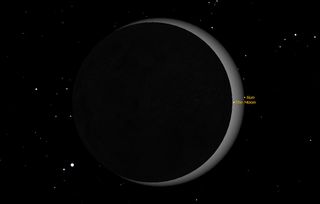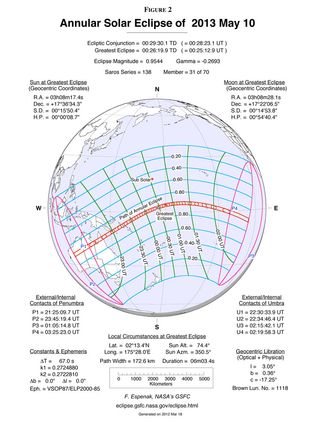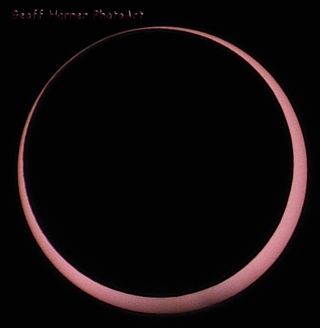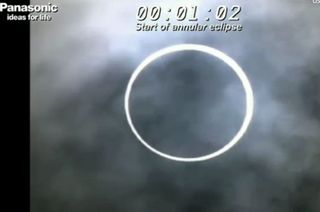This Week's 'Ring of Fire' Solar Eclipse: What You Need to Know

On Thursday and Friday (May 9 and 10), skywatchers in parts of Australia and the Pacific region will be treated to a spectacular "ring of fire" solar eclipse, in which the moon blots out all of the sun except for its outer edge.
Here's what you need to know about this stunning skywatching event, which is also known as an annular solar eclipse.
What is an annular eclipse?
The orbit of the Earth around the sun is an ellipse, not a circle. This means that sometimes Earth is closer to the sun than at others. The same goes for the moon's orbit around Earth, which is also elliptical rather than circular. [See Spectacular Photos of a 'Ring of Fire' Solar Eclipse]
We are fortunate to live in a time when the sun and the moon are very close to the same apparent size in our sky. This is an illusion of perspective: The moon is small (2,159 miles wide, or 3,475 kilometers) and close by (238,855 miles away, or 384,400 km) while the sun is large (865,278 miles wide, or 1,392,530 km) and far away (92,955,808 miles, or 149,597,872 km)
Notice that the sun is about 400 times larger than the moon in diameter. It is also about 389 times farther away. This explains why the two appear to be almost the same size in the sky. But "almost" is not exact, which explains why there are different kinds of solar eclipses — partial and total.

Distances in the sky are measured in angles, 360 degrees making up a full circle. Both the sun and the moon appear to be just slightly more than half a degree in diameter.
Get the Space.com Newsletter
Breaking space news, the latest updates on rocket launches, skywatching events and more!
Degrees are divided into 60 arcminutes. The exact size of the sun varies from 33 arcminutes when it is closest to the Earth on Jan. 2 to 31 arcminutes when it is farthest from the Earth on July 5. On May 10, it will be 32 arc minutes in diameter.
Over the course of a month, the moon' size also varies. On April 27, it was at its closest to Earth and appeared to be 33 arcminutes in diameter. If an eclipse had occurred on that day, the moon would have covered the sun completely, and we would have had a total eclipse.
On May 10, the moon will appear to be 30 arcminutes in diameter, since it is only a few days away from its farthest retreat from Earth, which occurs on May 13. A 30-arcminute moon doesn't quite cover a 32-arcminute sun, so the sun peeks out as a ring all around the moon. "Annular" is Latin for "ring," so the resulting event is called an annular eclipse. [How to Safely Observe the Sun (Infographic)]
Astronomers tend not to get as excited about an annular eclipse as they do about a total eclipse. Because the moon doesn't cover the sun completely, you don’t see the prominences and outer solar atmosphere, which are the most exciting parts of a total eclipse.
Thus I was quite surprised by the annular eclipse I observed from Toronto exactly 19 years ago, on May 10, 1994. Having observed a total eclipse in the past, I wasn't expecting much from this annular eclipse, yet I found it to be a very powerful emotional experience.
Even though 5 percent of the sun was still peeking around the moon, it had the same ominous feel as a total eclipse, much more so than the several partial eclipses I've witnessed. Seeing the "ring of fire" around the moon is far more impressive than seeing only part of the sun covered.

Where to see it
Unfortunately, very few people will get to see this annular eclipse, as its path travels over some of the most remote and unpopulated parts of the Earth.
The eclipse begins at sunrise over the wilderness of Western Australia. It then sweeps over the similarly empty Northern Territory and continues across northern Queensland, far to the north of the city of Cairns, where many people witnessed last year's total eclipse.
Only a few roads intersect the eclipse path. This path crosses the Coral Sea and touches the eastern end of Papua New Guinea, then crosses through the middle of the Solomon Islands. From there, the path neatly avoids just about every island in the south Pacific except for Tarawa and Fanning Islands, both part of the Republic of Kiribati, formerly known as the Gilbert Islands.
Although few people will see the complete annular eclipse, a much larger number will see it as a partial eclipse. This includes all of Australia, Papua New Guinea and the Hawaiian Islands, much of Indonesia, the Philippines and New Zealand.
Unfortunately the partial eclipse just misses being visible in North America, except just at sunset at the southern tip of Baja California. In Honolulu, maximum eclipse will be at 3:48 p.m. on May 9, when 32 percent of the sun will be hidden by the moon.
But anyone with a computer and an Internet connection will be able to catch a glimpse of the annular eclipse thanks to the online Slooh Space Camera. Slooh will air a webcast featuring expert commentary and views of the eclipse on Thursday starting at 5:30 p.m. EDT (2130 GMT). You can watch the broadcast live on SPACE.com.

How to observe it
For most people who may see this eclipse, it will be a partial eclipse. This is the most dangerous kind of eclipse, because people will be tempted to take quick glimpses of it without proper protection. DON'T DO IT! Looking directly at the sun is always dangerous and can cause permanent damage to your eyes.
There are two safe ways to view a solar eclipse. The first is with an approved solar filter. These can be purchased from telescope stores. The only safe equivalent is a #14 welder's glass. This is denser than the widely available #12, and it usually can only be found in dealers specializing in welding supplies.
The other safe viewing method is to use a large cardboard box to make a pinhole camera. Make a pinhole in one end of the box to act as the lens, and a large hole in the bottom of the box to stick your head through to view the image of the sun.
Natural pinhole cameras often are formed by gaps in window blinds or the spaces between leaves of trees. So don’t look at the sun — put your back to it and look instead at the ground in front of you.
Editor's note: If you live in the observing area of Thursday's solar eclipse and safely snap an amazing picture of the sun that you'd like to share for a possible story or image gallery, send photos, comments and your name and location to managing editor Tariq Malik at spacephotos@space.com.
This article was provided to SPACE.com by Starry Night Education, the leader in space science curriculum solutions. Follow Starry Night on Twitter @StarryNightEdu. Original article at SPACE.com.
Join our Space Forums to keep talking space on the latest missions, night sky and more! And if you have a news tip, correction or comment, let us know at: community@space.com.

Geoff Gaherty was Space.com's Night Sky columnist and in partnership with Starry Night software and a dedicated amateur astronomer who sought to share the wonders of the night sky with the world. Based in Canada, Geoff studied mathematics and physics at McGill University and earned a Ph.D. in anthropology from the University of Toronto, all while pursuing a passion for the night sky and serving as an astronomy communicator. He credited a partial solar eclipse observed in 1946 (at age 5) and his 1957 sighting of the Comet Arend-Roland as a teenager for sparking his interest in amateur astronomy. In 2008, Geoff won the Chant Medal from the Royal Astronomical Society of Canada, an award given to a Canadian amateur astronomer in recognition of their lifetime achievements. Sadly, Geoff passed away July 7, 2016 due to complications from a kidney transplant, but his legacy continues at Starry Night.

